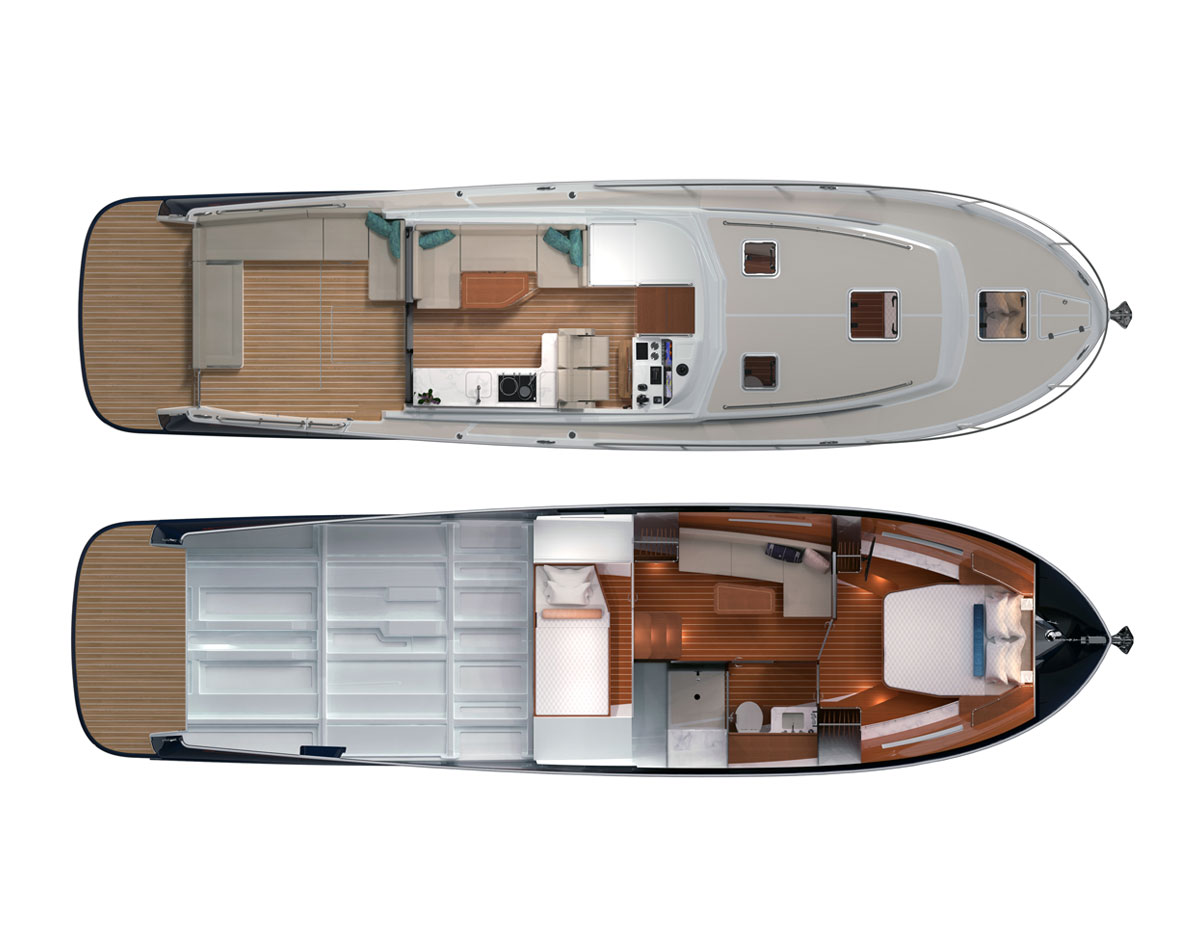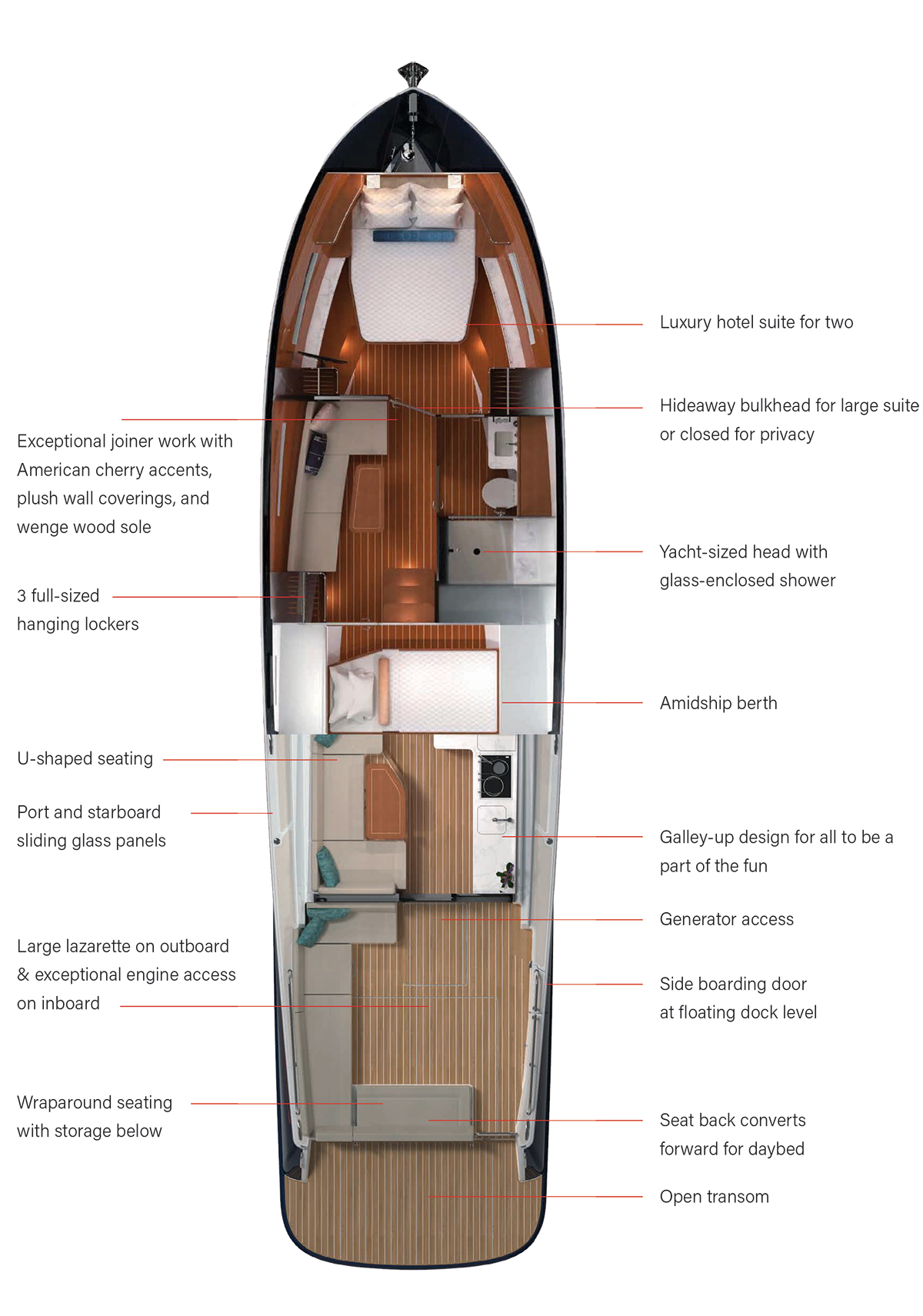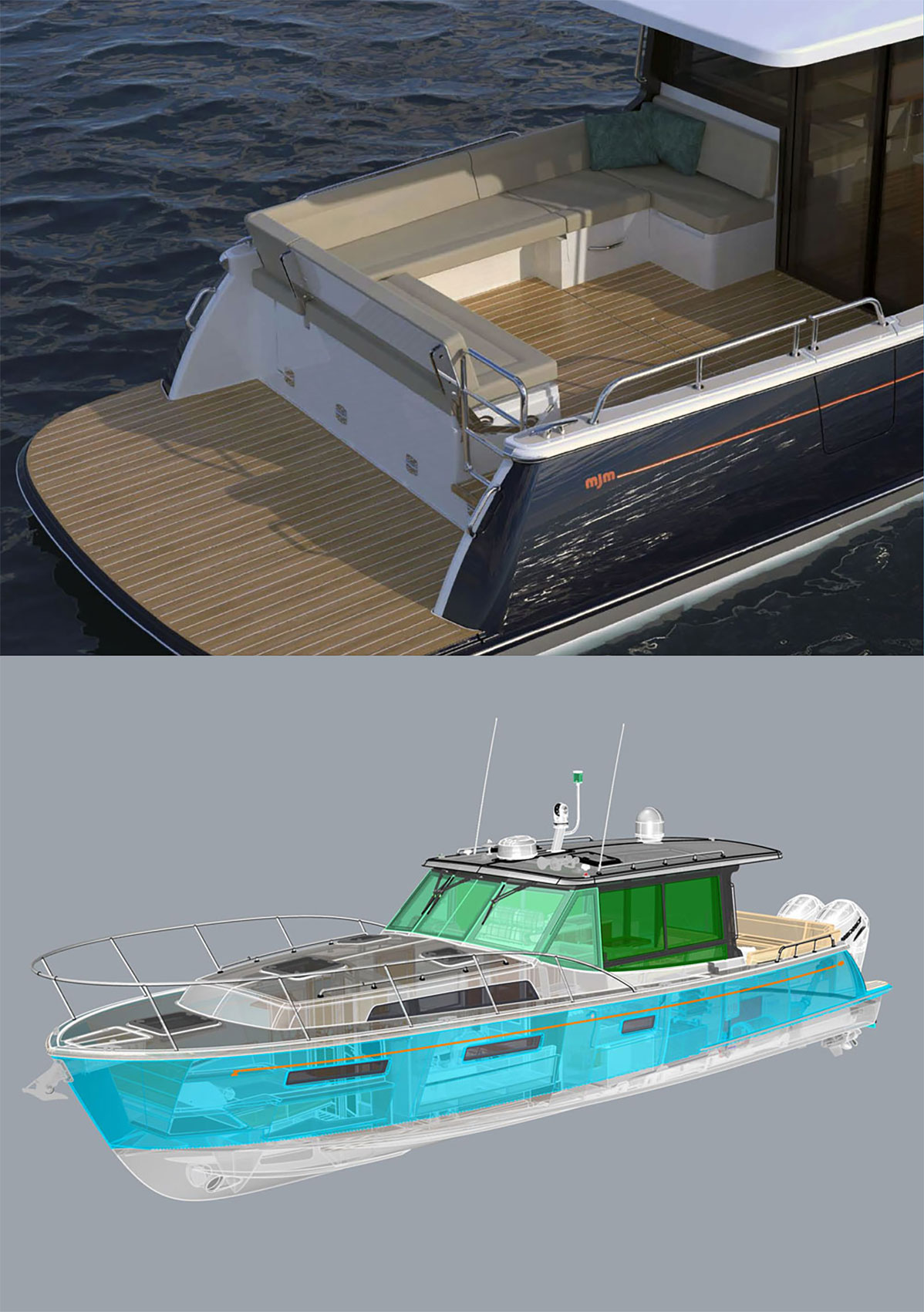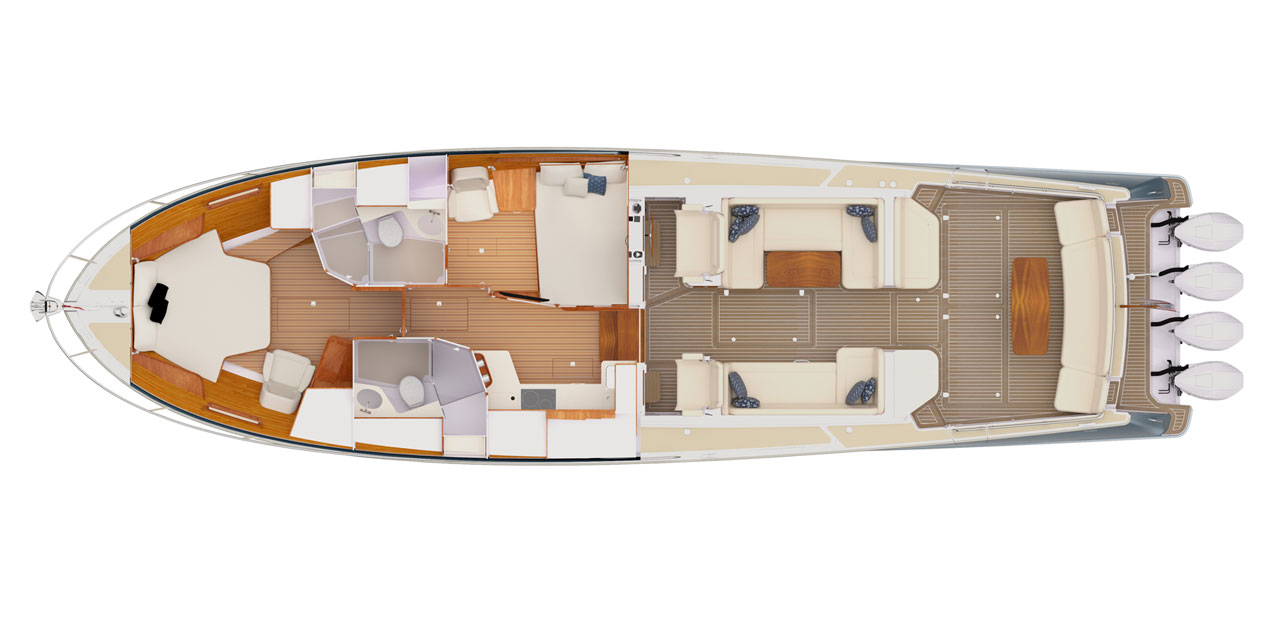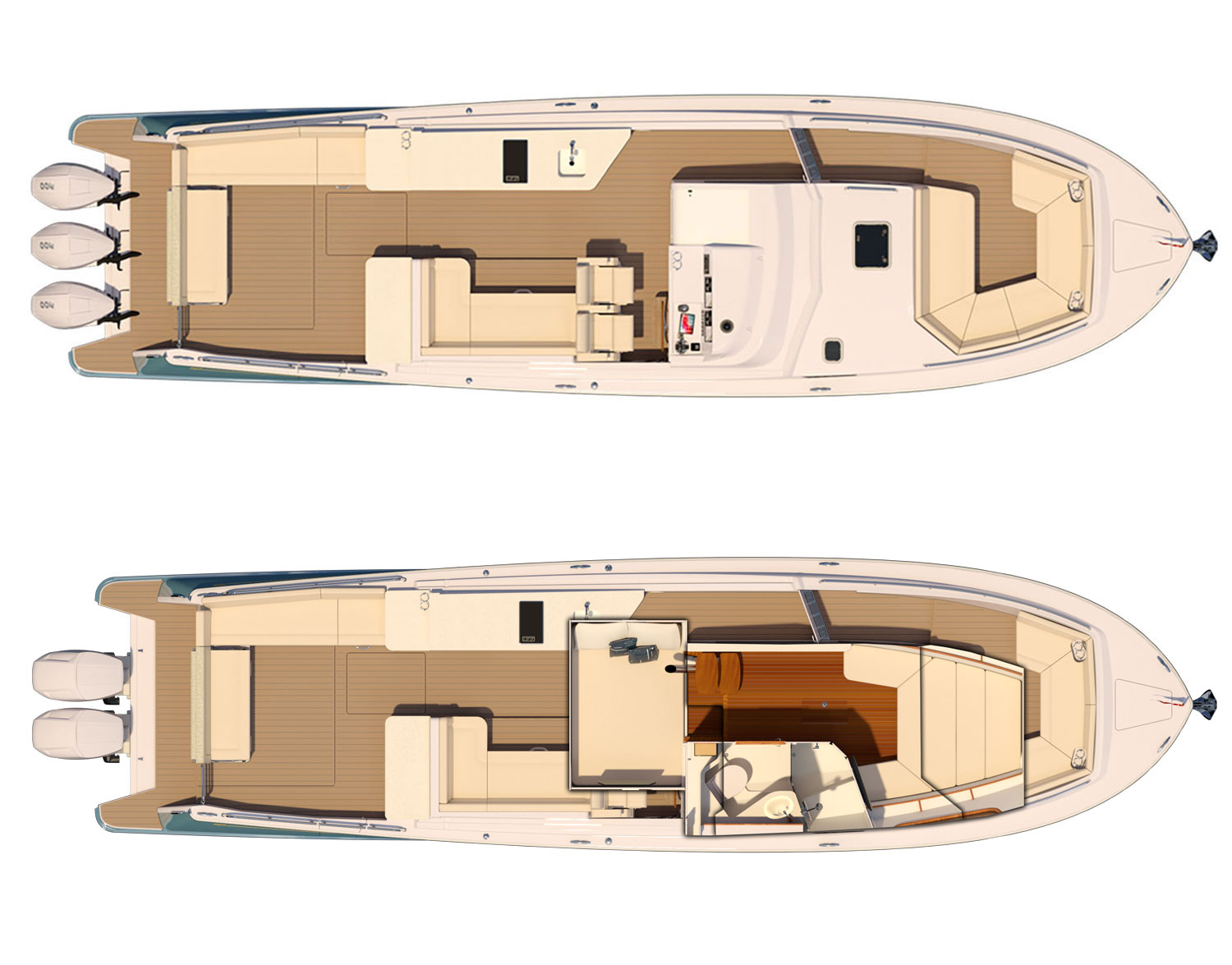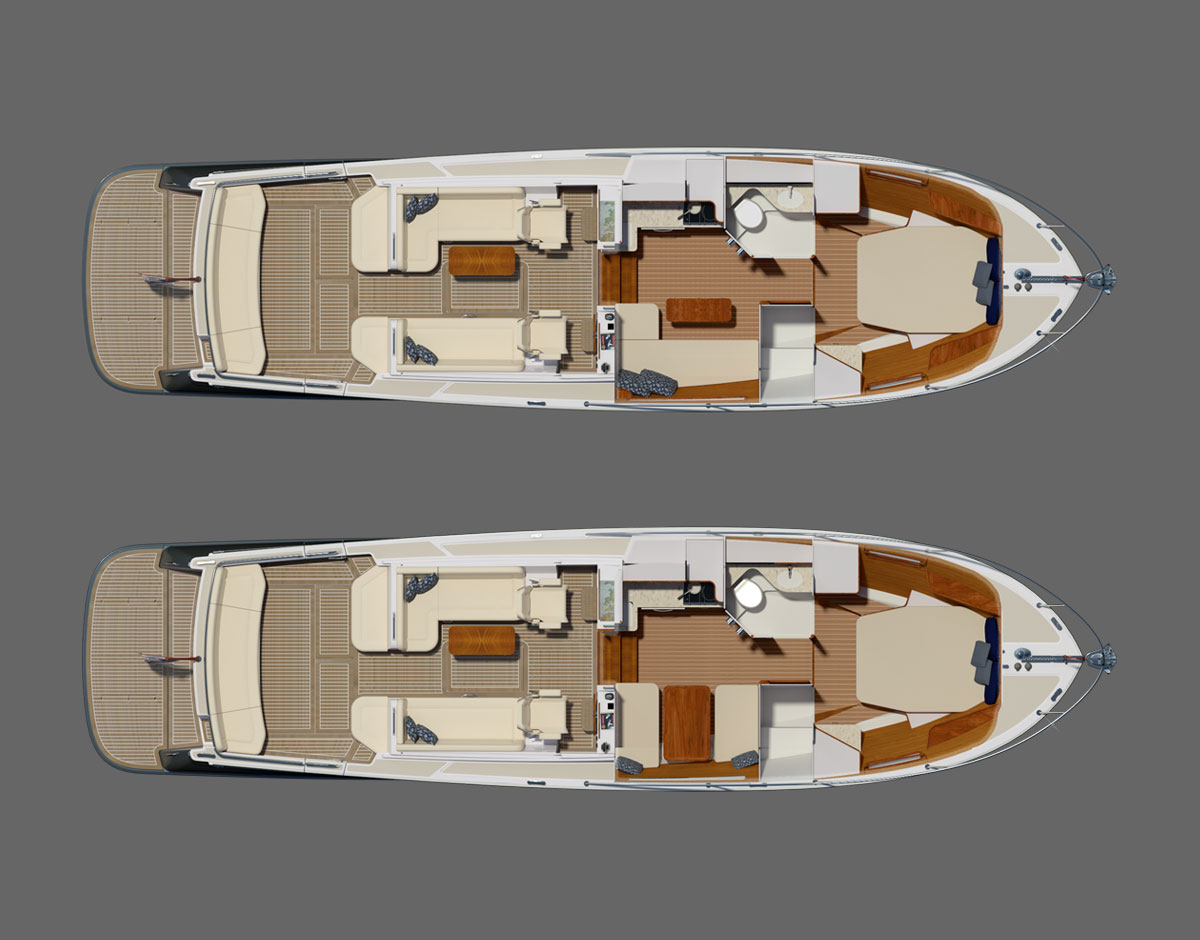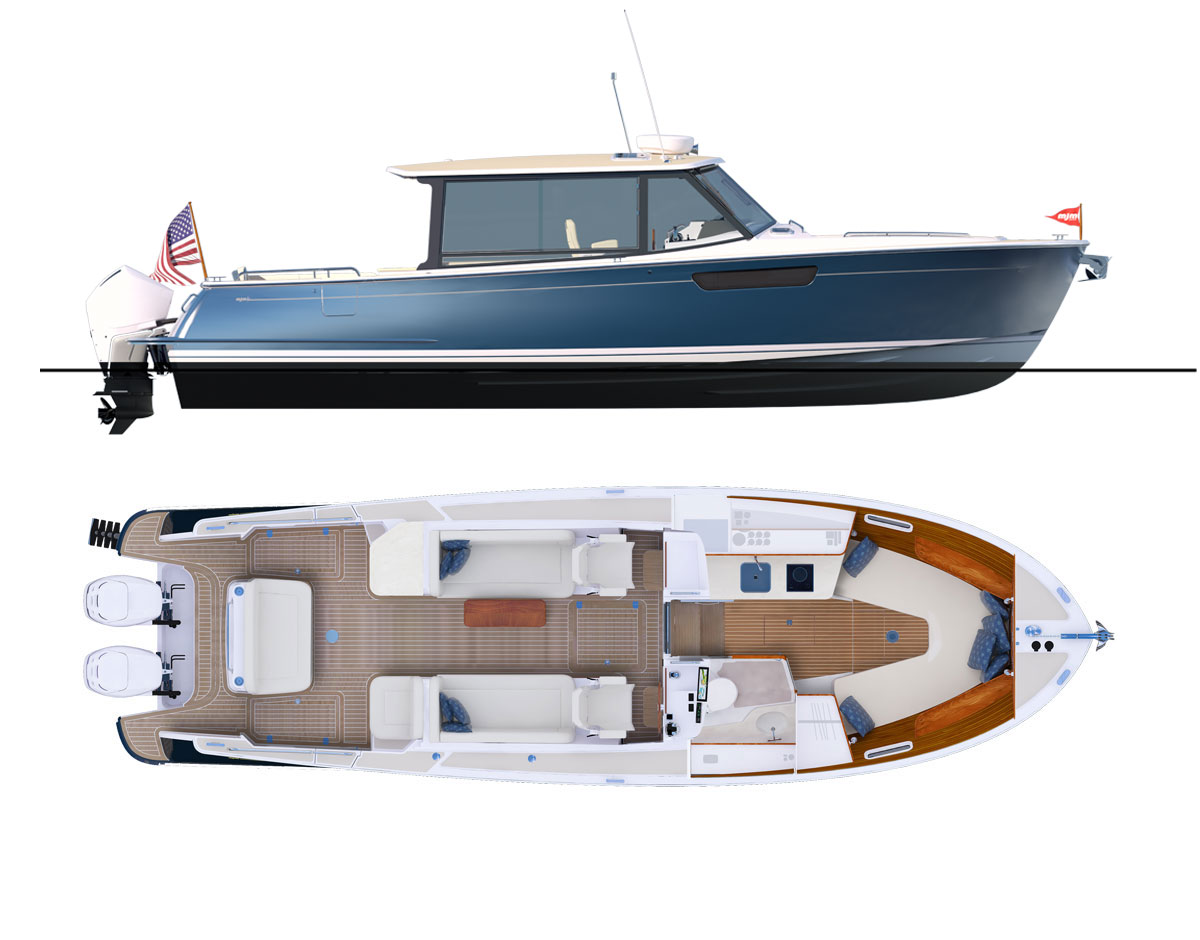The Art Of High-Tech Powerboats
Soundings
July 2020
Boston BoatWorks and MJM Yachts team up on vessels that marry the best attributes of speed, weight
When you get four sailors together to build powerboats, interesting things can happen. In my experience, sailors tend to develop an appreciation for and sensitivity to the elements that many powerboaters never do – wind and current, set and drift, stage of the tide, phase of the moon. Powerboaters, with the advent of GPS, may be aware of where they are geographically, but not necessarily nautically and situationally to the degree sailors are.

Scott Smith (left) and Mark Lindsay, founders and co- owners of Boston BoatWorks.Up on a powerboat, as opposed to down in a sailboat, one can be remarkably detached from nature, since the flick of a wrist can result in a pretty dramatic speed or course change, with current and wind having little impact on when or even whether one reaches the destination. When you sail, a 1 knot increase in course made good is a big deal, since increasing from 6 to 7 knots is a 16 percent increase in speed.
On the other hand, the owner of a planing powerboat is unlikely to pay much attention to a variation of several knots over the bottom. And since a 40-foot sailboat can make it around the world, an owner’s awareness of his vessel’s seaworthiness will likely be accentuated 1,000 miles from safe harbor.
For all of the above reasons, efficiency, seaworthiness, structural integrity and reliability are especially important to the seasoned sailor, and a study of how Boston BoatWorks builds boats makes a good deal of sense in this context, as well. The company builds the MJM line of powerboats, which I’ll get to in more detail after I tell you a bit more about how this company evolved.
Mark Lindsay and Scott Smith, the company founders and principals, are motivated by these elements and by what Lindsay refers to as wide-open curiosity.
“You have to really be driven in this business and you have to love it,” Lindsay told me during a recent visit to his company, which is located on Boston Harbor in East Boston. “I was captivated by sailing as a 7-year-old. People would tell me, you know, no one really knows how sailboats work, which of course was a way of saying they didn’t know how they worked. That just made me more determined to figure out how they work and, more importantly with my intense curiosity, how to make them go faster and more efficiently.”
Lindsay continues: “The amount of force available to make a sailboat go through the water is very small, and often you are making the sailboat go into the wind rather than with it,” he says. “This means that making the boat as efficient as possible is very important. This was all a mystery that I wanted to solve early on.”
With powerboats, Lindsay says, there wasn’t as much of a challenge. “All you had to do was wait until more powerful and lighter engines came along,” he says. “But to really optimize powerboat performance, which includes making it more efficient, you have to minimize weight and resistance, so that always presents an interesting challenge for us worth doing something about.”
And, of course, the same effort it would take to produce a half-knot increase in speed in a sailboat could easily produce an improvement of several knots in a planing powerboat.
Since he was young, Lindsay has investigated how sailboats work, the relationship between action (wind pressure on a sail) and reaction (forward hull movement), and what makes a vessel hold together or fail under the stress of open-water sailing.
He experimented with improving wooden rudder strength and weight by encapsulating the wood in fiberglass. He gradually learned from trial and error to build entire boats that were light and strong and that held together under demanding conditions. He also learned that if you are building with lightweight laminates and are creating volume for a forward cabin, you do not need to put as much boat in the water to support it. This allows for a hull form that can be finer forward, with a longitudinal center of gravity that is way aft and inherently has more reserve buoyancy.
Lindsay studied architecture at the University of Pennsylvania and MIT, and while the design work was enjoyable, breaking things in the structures lab and racing sailboats was even more fun. After a few years as a yacht designer with Dick Carter, he started his own boatbuilding company in 1975. His first boat, an International Fireball, won a world championship and during the next few years his company added world championship wins in various classes. As the business grew, so did the boats, and Lindsay soon was building winning ocean racers.
Scott Smith grew up sailing on Long Island Sound on his family’s 1923 wooden sloop. He spent as much time rebuilding the boat as sailing it, which explains his drive to build boats that are both reliable and durable while requiring little maintenance. In 1996, Lindsay and Smith launched Boston Boat Works as a high-end racing and performance cruising sailboat builder, coupling Lindsay’s composite boat building talents with Smith’s management and business skills, which included not being shy about pricing BBW’s services at a rate that kept them profitable.
Eventually, the two took on a wider range of projects that benefited from weight savings offered by advanced composites, including offshore yachts, high-speed power catamarans, fuel-efficient powerboats and wind turbines.
WEIGHT WATCHER

Peel ply and breather are placed over the laminate before the vacuum bag is applied; Kevlar is applied to the hull sides for added impact resistance; BBW’s impregnator wets out the fiberglass reinforcement to a precise 60/40 glass-to-resin ratio, the opposite ratio found in many open-molded boats.The part about minimizing weight is key to performance, since weight is the biggest factor influencing efficiency in a planing powerboat. It’s no accident that the way BBW manufactures powerboats – using prepreg epoxy vacuum-bagged laminates – is the best way to minimize weight while maintaining adequate strength and stiffness in a hull structure. Why epoxy? Compared to the polyester resins used in most production boats, epoxy has more elongation – more than the fiberglass with which it creates a matrix – so the laminate is much stronger. Polyester resin is more brittle, stretching less than half as much as the fiberglass strands it surrounds before it cracks, so it will fail well before the glass is fully stressed.
Epoxy also is a much better adhesive, so the integrity of the structure is superior. It also is more impervious to osmotic blistering because of its tightly linked molecular structure. It’s not cheap and it takes special care to work with, but it’s the superior resin and creates a far better laminate.
The prepreg process ensures that resin content is controlled to optimize the laminate’s strength and minimize weight. Excess resin makes the structure heavier, weaker (more resin means the laminates are not as tightly compressed, with more space between layers) and more brittle.
A sailboat needs weight down low (weight stability) to resist the heeling effect of wind on the sails. This is done by making the center of gravity much lower – adding lead down low in the keel – than the center of buoyancy so a righting arm is created as the boat heels. Buoyancy creates an upward force, gravity a downward force, and the degree and horizontal distance between the two creates a couple to right the boat. As weight goes up in a displacement sailboat, however, so does frictional drag, as the hull settles deeper in the water, so the key with a sailboat is to get just the right balance of righting power and hull resistance. “In a powerboat, it’s not nearly so complicated,” says Lindsay. “Here, the goal is simply to reduce weight, since the center of gravity takes care of itself.”
By that he means that the hard chine planing hull is kept upright by form stability, not weight stability, with the shape of the hull – the form – creating the righting moment, though through a substantially narrower range of stability.
FULL CIRCLE
Smith and Lindsay attended a seminar last year at the International BoatBuilders’ Exhibition and Conference during which a slide of an infused hull being built in the late 1950s was shown. So why aren’t all boats being built using high-tech processes like prepreg epoxy or resin infusion today if they were doing it 50 years ago?
The answer, in part, is the invention of the chopper gun, which made mass production in open-molded fiberglass not only possible but cheap, and the advent of more powerful, lighter weight engines, which overcame by brute force the extra hydrodynamic and frictional resistance that heavier boats produce. (Boatbuilders today design boats around available engines, whether inboard, outboard or pod power.) To illustrate the point about brute force being easier to create than a slippery, lightweight boat, the next slide showed a 45-foot go-fast with quadruple 300-hp outboards. This was followed in turn by an illustration of what we’ve largely missed out on in the intervening years – a 10,000-pound 34-footer with a single diesel. Quite a juxtaposition.
An interesting corollary is that twin 4-stroke outboards can be as efficient as inboard diesels at cruise. While the diesel produces more horsepower for the fuel flow, the outboard can trim the bow up, increasing efficiency by reducing wetted surface and drag. Many twin diesel cruisers and sportfishermen these days are grossly overweight, which requires bigger engines, more fuel and so on. Take one popular 1,600-hp, 40-foot convertible that makes just 35 knots at less than .48 nmpg.
BBW AND MJM
It’s meaningless to talk about Boston BoatWorks without the subject of MJM Yachts coming up. The Boston company, whose line of lightweight, high tech powerboats is built by BBW, is owned by Bob Johnstone, a man unbound by convention. He is the founder of the J/Boats and something of a legend in the racing and cruising sailboat worlds, with more than 10,000 Js built.
Johnstone and his wife, Mary (MJM stands for Mary Johnstone’s motorboat), had owned a Dyer 29, a semidisplacement Down East hull that’s been in production since 1958. But he had something else in mind and it helped that achieving such success in the sailing world demands a thorough understanding of hull efficiency and the requisite high-end construction to produce light-and-strong boats.
Johnstone saw a latent market for powerboats that would be built with the same care as his high-end sailboats, boats that were simply outfitted, easily propelled, easy to own and strongly built. He had observed through the years a malignant condition he called “featuritis” – people wanting more and more stuff on their boats, such as icemakers, granite countertops, inverters with their own battery banks, washer/dryers and vacuum systems, and an extra generator to run it all. Simplifying how a boat is outfitted has the benefit of reducing weight, cost, maintenance and the chances that something will break on a given day on the water, all of which are goals of the MJM series.
Johnstone approached designer Doug Zurn about creating a powerboat with these qualities. In addition to solid engineering, it had to have a look that would sell to well-heeled boaters, some of whom had spent their lives sailing. Zurn produced some initial drawings, and after some back and forth (14 emails, Johnstone recalls), Johnstone was hooked – he’d found his man.
Zurn had drawn a pretty, low slung, well-proportioned 34-footer. (The look is patented, an unfortunate reflection of our litigious times.) He paid close attention to the boat’s proportions, making it more slender than most powerboats today, which improves efficiency, comfort and seakeeping. Many boats today are so beamy and stable that they are over-reactive in a seaway, conforming as they must to the wave gradient. This snap roll quickly wears a person out, making the boat exhausting to be aboard. The 34z (the z, of course, stands for Zurn) ended up with a single diesel, bow and stern thrusters, a 25-knot cruise speed and good fuel economy – nearly 2 nmpg.
Lindsay says selling a 40-footer at a boat show that’s smaller than the 38-footer next door is not always easy. “An MJM sells on the basis of simplicity and elegance,” he says. “It takes a different sales approach and it’s challenging to sell at a boat show where-built in vacuum cleaners and large-screen televisions are the norm. But people that know boats are the easiest to win over. For one thing, they just walk through the side door, like they would from a dock, and the next thing they know they’re on the boat – no gunwales to climb over.”
CONSTRUCTION

An MJM 40Z fresh out of the mold and Awlgripped and ready for delivery. This is the Downeast version of the boat, which also is available in an Express model.Lindsay has been building all-epoxy boats since 1975. Achieving the greatest strength and stiffness at the lightest weight has been a consistent goal for BBW. The boats are built to the European CE construction standards, which among other things specify the laminate at the keel and chines. Core- Cell foam is used to core the entire hull, deck and superstructure.
The core separates two thin layers of Kevlar (in the outer skin) and fiberglass laminate, creating a continuous I-beam that is stiff, strong and light. Lindsay says BBW favors Core-Cell because it eliminates outgassing (the slow release of gas trapped in the foam during manufacturing); stands up better under solar heat, especially aft at the tumblehome on dark hulls; and its favorable physical properties combine good stiffness and impact resistance.
The hull starts with a polyester gelcoat followed by a vinylester resin tie coat, since epoxy won’t adhere directly to the gelcoat. Next comes a skin coat of 6-ounce fiberglass cloth wet out in epoxy, which is allowed to set up, preventing print-through of the follow-on laminate.
BBW has its own impregnator, essentially a set of rollers with a resin tub. The fiberglass is pulled through the resin tub and then through the rollers, which squeeze out the excess to create a ratio, by weight, of 60 percent fiberglass and 40 percent resin, precisely the opposite proportions found in most open-molded boats. The two-part epoxy is mixed before going into the tub, and workers have a fourto six-hour working window with the BOATSHOP catalyzed resin to complete the laminate.
The outer hull skin, which starts with the gelcoat and skin coat, includes a layer of Kevlar reinforcement and two layers of biaxial fiberglass, one 45/45 and one 0/90 in orientation, providing uniform strength in all directions. Next comes the Core-Cell followed by a thinner inner laminate. The thickness of the Core-Cell depends on the size of the boat – 1 inch in the 40, 3/4 inch in the 34, for example. A hull grid of foam-cored stringers and bulkhead landings is installed at the same time and encapsulated in a fiberglass laminate.
A plastic sheet that forms a bag covers the entire hull and grid, vacuum lines are installed, the edges are sealed and the vacuum pump is turned on, clamping the stack of materials under more than 2,000 pounds per square foot of pressure. The pressure compacts the inner and outer skins and forces them tightly against the core, producing a solid skinto-core bond without compromising gaps, air voids or irregularities, which in turn creates a structure of unusually high strength for the weight.
Vacuum-bag compression of the wet laminate evacuates air from the plies and presses the glass fibers in close contact with each other, helping the laminate work as a single unit to transmit loads. In fact, this is much like a composite airplane is built, which says something about the integrity and fatigue resistance of the method and materials.
The hull is made in two pieces in a two-part split mold. Since the boat has a lot of tumblehome, pulling the hull up and out of a one-part mold would be impossible. This also makes the lamination and bagging process a lot easier, because it puts the port and starboard hull sections, which are half as wide as the completed hull (one hopes), within easier reach of the shop floor.
The area along the keel is solid glass, and when the two hull sections are set alongside each other for the first time, the tapered fiberglass sections at the keel are glassed together under vacuum. The foam core butts right up to the chines at the hull sides and bottom, with fiberglass overlapping this high-stress area – think of the compression resulting from the boat being held aloft in slings. Like the keel, the upper 4 inches of the hull (the sheer) is also solid glass for added strength. There are no hull-to-deck fasteners.
The deck is built like the hull, with two outer skins of fiberglass sandwiching a Core-Cell core. What’s important here is creating decks that are not only strong, but stiff. You can have a strong deck, one that will support a heavy load, but if it deflects noticeably under foot, it seems weak, and since the customer’s perception is the builder’s reality, this is a perception avoided by the alert boatbuilder.

The systems are as well engineered as the boats are built; this computer representation shows the temperature of the hull laminate at 16 different points mon- itored during post-cure, which ensures the structure is maintained at 150 F for the full 24 hours it’s in the oven.The hull and deck are post-cured for 24 hours at 150 F by installing a temporary oven structure around the boat that contains the heat. The prolonged heat causes the epoxy resin to cross link and cure at the molecular level. Once cured and the cabin modules are installed, the hull and deck are bonded together with a high-strength methyl methacrylate adhesive.
While the hull and deck structure make up only 21 percent of the total weight of the ready-to-use boat, MJM models are noticeably lighter than same-size (length by beam) boats built of conventional open-molded fiberglass. This translates to higher speeds on the water. And MJM emphasizes simplicity and reliability, so the boats aren’t loaded up with stuff that can break and/or slow the boat down.
The benefits of advanced composite construction can be seen in the MJM 40z, which has a 2,000 pound hull and a 1,250 pound deck. Lindsay estimates that the same parts open-molded with polyester resins would weigh 50 percent more for the same strength and stiffness.
Epoxy’s toughness is demonstrated by its elongation under tensile loads without breaking. Epoxy can stretch three times more than polyester resin and 25 percent more than vinylester. It is also has far stronger adhesion to both the fibers, itself and to other resins. Kevlar is used to resist impact and puncture damage as a sort of safety net. An equivalent weight of Kevlar is almost twice as strong in tension as fiberglass. Fiberglass, however, has better compression stiffness and therefore is used in conjunction with Kevlar for the strongest, stiffest hull.
THE MJM LINE
There are four models in the MJM lineup – 29z, 34z, 36z and 40z – and each is available with two pilothouse side-window options. The Express has a raked side windows with a vent, and the Downeast variant is open from top to gunwale with plastic side windows that fold up. The latter allows you to open up the pilothouse to the outdoors and you can pick up a dock line from the helm, like a lobsterman catching a pot warp.
All MJMs are not only attractively proportioned and styled, but are also beautifully finished, with a blend of cabin materials that prevents the wood paneling from being overpowering. The boats have an emphasis on topside cruising and entertaining, and the 40 has half its length given over to accommodations below, making it a comfortable short term liveaboard as well.
The decks are a single level from cabin bulkhead to stern, which adds volume aft, unlike boats that step down from the helm area to the cockpit. This works well for the 36z and 40z, which have twin sterndrives and, therefore, aft engine rooms. (The 40 is available with optional Volvo IPS power.) With the power aft, they need the extra cockpit height anyway, as does the sterndrive-powered 29z. (A bracket-mounted outboard version is also available.)
You’d be hard-pressed to find a combination of construction and propulsion technologies that delivers better economy than an MJM with Volvo IPS or diesel sterndrive power.
The 40z weighs 3,000 to 6,000 pounds less (dry) than a number of 35 to 36-footers with enough beam to make them the same size overall. To get an accurate and fair performance comparison, however, don’t compare the 40z to other 40s that are much beamier. Compare it to a boat of the same size overall – say, a boat that’s 37 by 13 feet.
The moderate length/beam ratio of the MJM hulls intrinsically improves efficiency while improving the ride over a shorter/wider boat of similar deadrise. IPS is more efficient than conventional inboards by 20 or 30 percent, and this combination makes the pod-powered 36z and 40z, as well as the diesel sterndrive-powered 29, very efficient. Consider that the 40 gets 1.3 nmpg at 24 knots, double that of some 40-footers. To further put things in perspective, many 32to 33-foot conventional twin-diesel boats get only 1.2 to 1.3 nmpg.
Building to European CE standards means MJM boats must pass engine noise and emissions standards, and they also are required to have an extra manual or portable pump, fire extinguishers, nonreturn (check) valves on discharge hoses, and additional labeling. The boats are looked at closely and given a rating for use. For example, the 40z is certified for “Offshore” category use in speeds to 45 knots and seas to 21 feet (just not at the same time, of course). This is a good thing, because people here in the United States are often led to believe their condo boats are suitable for use 30 or 40 miles out when they are decidedly not because of their sail area, marginal stability, snail-like speed capability in rough seas, rough-water ride and seakeeping.
Since Boston BoatWorks started building MJM boats in 2003, 108 hulls have been delivered. These fellows may be sailors at heart, but they have adapted to powerboat-think nicely. For example, the twinsterndrive 36z has its engines mounted as far outboard as possible to maximize the twisting torque available from the propellers, which improves maneuverability.
There’s much more information about these boats on the MJM Web site (www.mjmyachts.com) and pricing is as follows. The 29z is $318,000 base, $380,000 loaded; the 36z is $467,000 base, $630,000 loaded; and the 40z is $795,000 base, $900,000 loaded. Like the 36z. the 40z is available with diesel sterndrives.
CONCLUSIONS
Bob Johnstone teamed up with the right builder in Boston BoatWorks. It’s the strongest construction for the weight I’ve yet seen, based as it is on Lindsay’s experience building high-end racing sailboats, vessels that are subjected to far higher stresses than the typical powerboat ever is. These are marvelous works of art, the real deal in terms of construction methods and materials. A talented manager, Scott Smith runs a tight ship. Doug Zurn is an artist when it comes to drawing a pretty boat and, fortunately, Johnstone’s vision for these boats allowed him to keep the profile low and the beam moderate, making the designer’s job much easier. Head over to the Boston waterfront and see for yourself what this gifted team is capable of.

Eric Sorensen started the J.D. Power and Associates marine practice and authored “Sorensen’s Guide to Powerboats: How to Evaluate Design, Construction and Performance.” He consults for boatbuilders, government agencies and boat owners. He can be contacted at (518) 324-7700.

